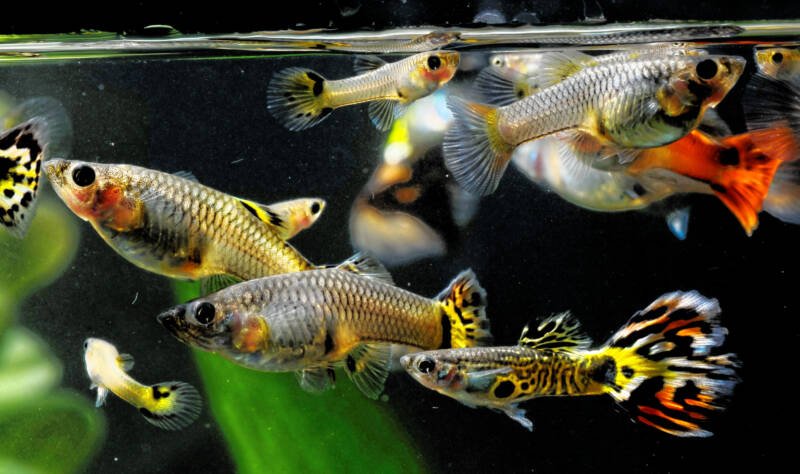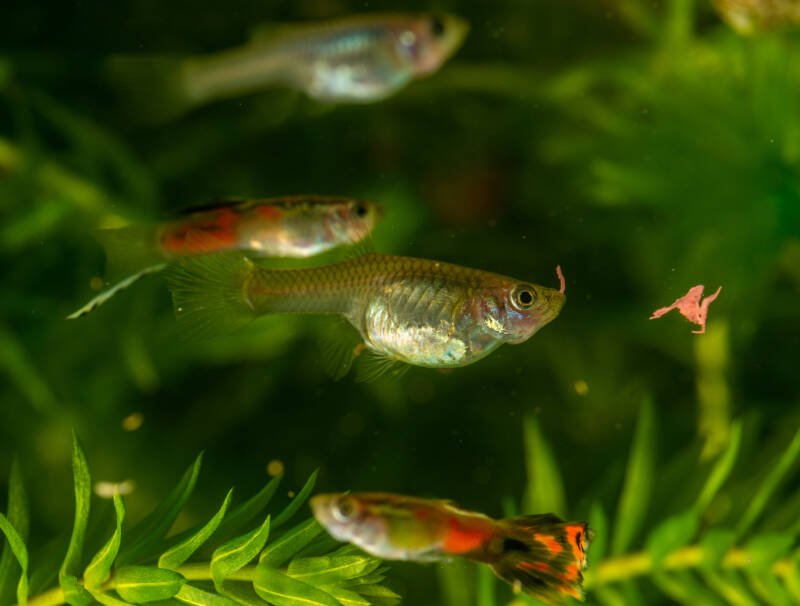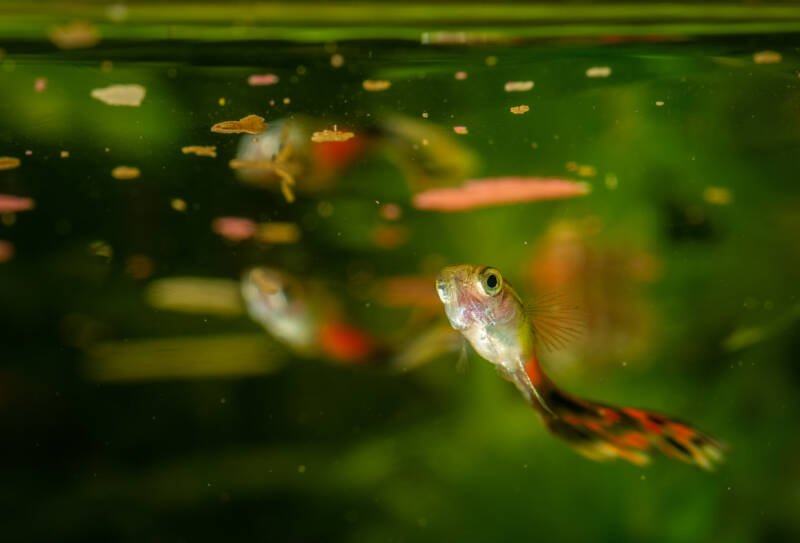Feeding guppies can be a daunting task. On the one hand, they eat everything you throw at them; on the other hand, there are so many choices on the market that it becomes confusing when selecting food.

Foods have different qualities that hobbyists search for. Some are small pellets, while others come in the form of flakes.
Luckily, choosing good food isn’t as tricky as it sounds.
In this article, we’ll take you through what you should be feeding your guppy and a few of our top picks for guppy foods!
In this article
Guppy’s Diet
If you don’t know, guppies are a small species of freshwater fish that originate from South America. Yes, from the mighty rivers of the Amazon!
To date, there are about 300 different types of guppies that have been documented.

In the wild, a guppy’s diet consists of various plant and animal matter, including anything from algae to insect larvae.
Guppies are opportunistic feeders and live just below the surface of the water. They will consume the organic matter that may fall through the surface.
In the home aquarium, though, things are slightly different.
Many owners feed an exclusive diet of commercially available food items. Most of the time, this consists of either pellets or flaked food.
It is still best to vary their diet with “wet” food such as frozen bloodworms or brine shrimp to keep your fishes healthy.
Occasionally, there are problems like impaction or bloating when too much-processed food is fed.
Types of food available

In the market today, you’ll see a myriad of food items suitable for your guppies.
It is not wrong to feed your guppies exclusively off a single food item.
However, it is highly recommended that you vary their diet from time to time to boost their immune system and stimulate their digestive tracts.
Pellets

A popular option, pellets are usually the go-to choice for food when it comes to feeding guppies.
They come in various options, such as size and whether they sink or float.
One of the bigger benefits of using pellets is that they tend to dissolve slower. This means they don’t foul the water as much as compared to other types of food.
However, they do come with some slight disadvantages as well.
Pellets are dehydrated and can sometimes cause impactions or blockages in fish.
While this does not happen very often, it can be dangerous and kill your guppies if left untreated.
A simple solution to pre-soak the pellets before feeding will curb these issues.
Below is a list of pellets that we’ve used before and have had much success with.
- Hikari Tropical Fancy Guppy
A well known Japanese brand that has long since produced some of the best fish food we’ve tried over the years. Their food is not only packed with nutrition but also very tailored to specific fishes. - Fluval Bug Bites Tropical Fish Food
Fluval is another excellent company that produces some phenomenal products. The Fluval Bug Bites is designed for small to medium fishes and is packed with nutrition as well! - Tetra Tropical XL Color Granules
Tetra is a company that has years of history and produces great food! These pellets come with a natural color enhancer that brings out colors in your fish. These are slow sinking pellets that are suitable for almost any small to medium fish in the tank. - Hikari Micro Pellets
These micro pellets are a great option if you have other small fishes in the tank, like neon tetras or platies. They are slow sinking pellets that do great if you have fishes that inhabit the mid-water column as well! - Cobalt Aquatics Ultra Pellet Guppy Nano Bits
Cobalt Aquatics is also another company that produces some high-quality products. Their guppy food features pellets that are jam-packed with nutrients and all-natural ingredients!
Flake food

Flake food has been around since the beginning of fishkeeping.
It was a popular choice in the past due to its availability and cost, making it a very attractive option, especially for novice fishkeepers.
Although the popularity of using flakes has declined in recent years, many aquarists still choose to use it.
Using this type of food also has many advantages. For one, it tends to dissolve easily in water, which usually entices finicky eaters to eat.
Also, because of the ease of dissolving, it tends to cause less digestive issues.
However, they do have significant disadvantages, which make hobbyist steer clear of them.
One of the biggest drawbacks of this food is that they tend to foul the water quickly.
Also, because of its delicate nature, it’s very easy to overfeed flake food.
Flakes are still a viable food option, especially if your fishes are small but finding a small enough pellet size is a problem!

Below are some popular choices of flake foods that we’ve used with much success:
- TetraMin Tropical Flakes
TetraMin flakes boast a highly digestible formula that has all the nutrients your fish needs. The great thing about this is that it is fuss-free and has grown over the years to be go-to fish food for many keepers.TetraMin flakes also feature a clear-water formula that supposedly will not cloud water. While this seems to be accurate, any amount of overfeeding is still going to foul the water. - Aqueon Tropical Flakes
These flakes are as simple and affordable as flake food gets. The Aqueon Tropical Flakes are formulated with all-natural ingredients & nutrients your fish will need for a healthy diet. - TetraMin Tropical Flakes Plus
Another flake food by Tetra, this flake food is the same as the first option above. Except this one has been formulated with shrimp for flavor enhancement for better feeding response. - Fluval Hagen Color Enhancing Flake Food
The Fluval Hagen is also another excellent flake food to try out. Formulated with Norwegian krill, these flakes make a great staple meal for your guppies. It is also packed full of proteins, antioxidants, and vitamins! - API Tropical Flakes
Apart from the API test kit we’re all familiar with, this company also makes some good and affordable fish food. These flakes are made of a protein-rich formula designed to keep your fish healthy and water cleaner.
Wet Food
Wet food can include both live and frozen ones.
Brine shrimp, frozen bloodworms, tubifex worms, mosquito larvae, etc., all make great food for guppies.
Although feeding wet food can cause problems occasionally, it is generally considered safe. As long as the food is obtained from a safe source, the risk of disease is minimal.
It works great in creating variety for your guppies’ diet.
What’s important to note is that wet food creates a very strong feeding response and is often used to entice recovering fishes to eat.
On top of that, wet food often contains certain nutrients usually absent in dry food, such as omega 3, amino acids, and fatty acids.
In their natural environment, guppies eat various food items, so it is best to mimic what they eat in the wild to ensure a healthy and balanced diet.
Homemade Food
Most experienced keepers we’ve come across feed a variety of the food items mentioned above.
However, what sets them apart is that they also include some homemade food for their guppies.
While it can be a tedious process to prepare and feed homemade food, it is usually one of the best option for any fish.
Being able to control the amount of each ingredient will ensure a balanced and nutritious feed if done correctly.
However, it often involves a lot of time and effort, so not many hobbyists opt to make their own fish food at home.
But homemade guppy food can be easy as slicing up a few pieces of fresh cucumber or a few pieces of an apple as a treat for your fishes.
Not only do these treats vary their diet, but they also inject a fresh dose of vitamins and minerals.
Homemade meals also have the added advantage of including many nutrients that is absent in dry food.
Some typical fresh food you can dice up:
- Cucumbers
- Boiled egg with egg yolk
- Cabbage
- Kale
- Spirulina
- Fish
- Chicken breast
- Apples.
It is important to note when preparing a homemade meal is, their diet is protein-rich. Such things as meat and egg yolk should make up the bulk of the meal.
Another essential thing to take note of is that guppies have tiny mouths.
This means, when preparing anything, be sure to chop it up into small pieces. If not, your guppies will have a hard time eating.
There are also certain food items that you should stay away from. While not harmful to us, these items are not beneficial and sometimes will quickly foul the water.
Some items to stay away from :
- Bread: Fouls water quickly and has virtually no nutritional value to your fish.
- Oily food: It also quickly fouls the water and will create a film of oil on the surface, preventing oxygen exchange.
- Processed food: Things like luncheon meat and sausages are bad for fish because of the chemical preservatives used. That can be poisonous to your fish.
FAQ
In this section, we talk about some of the commonly asked questions people have regarding feeding guppies.

How to feed guppies?
Feeding guppies is usually a simple task if you have healthy fishes.
As they often stay near the surface of the water, we recommend feeding any sort of floating food or slow sinking pellets.
The problem usually comes when feeding sick fishes as they may require some enticing.
For these cases, we recommend feeding fresh wet food such as chopped up fish or shrimp.
How much should I feed my guppy?
The general rule of thumb is to feed as much as they will consume within 5 minutes.
However, we’ve found that to be slightly excessive and recommend feeding them as much as they will consume within 3 minutes.
This is because they will graze on algae and other things throughout the day. Feeding them slightly lesser is fine and ensures optimal water quality.
How often should guppies be fed?
Guppies are active fishes that move around and expend a lot of energy throughout the day. Therefore they should be fed slightly more than other fishes.
While we usually feed our fishes twice a day (once in the morning and once in the evening), we have met owners who feed their guppies 3-5 times a day!
However, twice a day or even once a day will suffice if you feed sufficiently.
How long can guppies go without food?
Like what we’ve mentioned earlier, guppies are always on the move and expending energy. They require food intake to sustain their energy output.
Unlike other slower-moving fishes, guppies will not last very long without food, possibly a maximum of 3-4 days.
However, there is usually plenty of food in the tank, from algae to plants and other smaller organisms that we may not see with the naked eye.
For hobbyists who want to go on a holiday, employing an automatic feeder will come in handy.
Closing Thoughts
Feeding guppies is a simple task considering they eat almost anything.
What is more important is ensuring that you feed your guppies a balanced diet.
You probably can survive on a diet of solely fried chicken, but you probably won’t be a very healthy person. The same goes for guppies!
Varying their diet can be as easy as adding a few pieces of carrots or cucumbers on a few feedings a week.
Not only does this keep them in tip-top condition, but it also builds up their immune system! As fresh food has nutrients that commercially available feeds do not.
That said, we hope you’ve enjoyed this article as much as we’ve enjoyed putting it together.
Do leave us questions and comments in the section below!